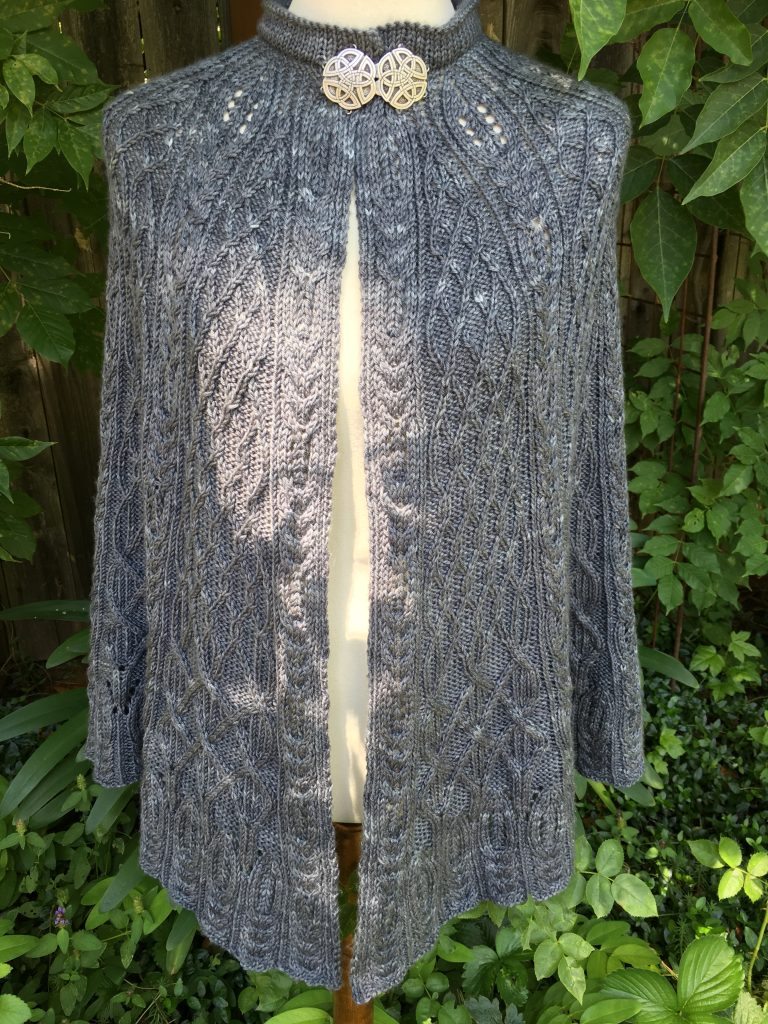July 2019
I have often talked about how healing knitting can be. It is therapeutic. In fact, I have a project bag that says, “Cheaper than Therapy.” I’m not sure that is accurate, given the very low therapy reimbursement rates and the very high cost of good yarn, but knitting is good therapy.
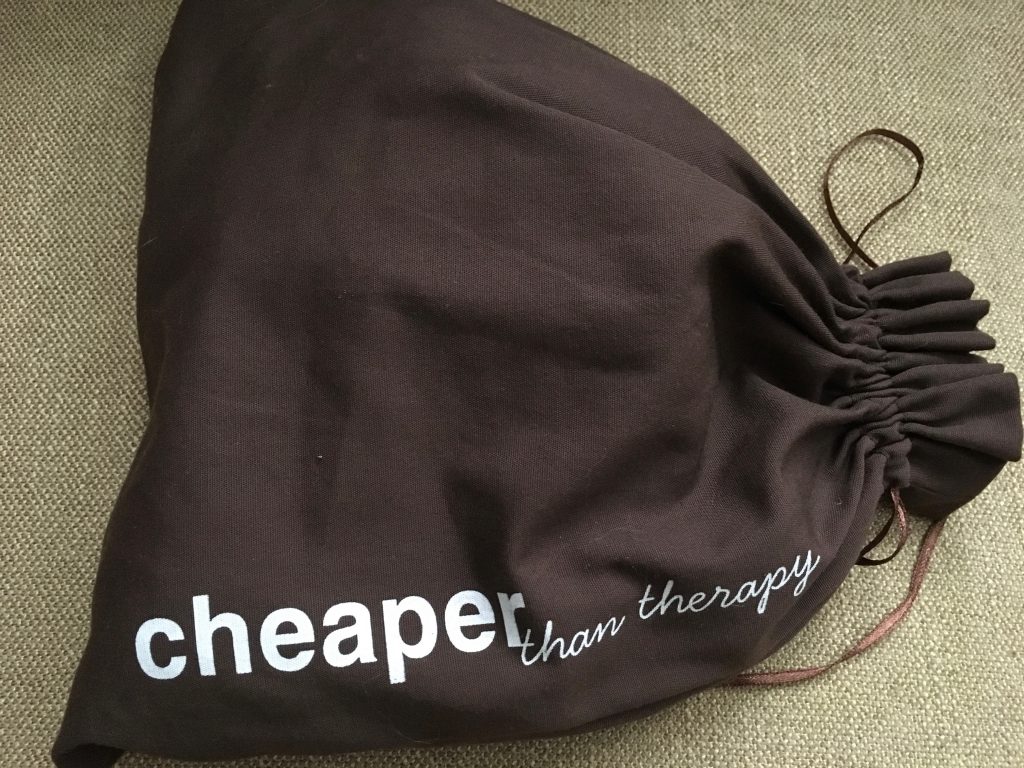
Knitting builds community, reinforces efficacy and agency of an individual, distracts one from challenging issues, and there is absolutely NOTHING else in life that you can so easily undo. Think about that. Maybe because I was a single parent with so much riding on my shoulders, maybe because I held people’s lives and minds in my hands in health care for over 40 years, maybe because I was witness to so much suffering in pain in others, that seems like a great thing to me.
Community: Knitting brings together people who otherwise would not spend time with one another or get to know each other. People share with one another, help each other, and, yes, let’s be honest, enable each other. And most often, knitters are very nice people when they sit and knit together. Most often there is comradery, support, and a bond that develops.
Efficacy: There is nothing like completing a project to know that you can accomplish things. (This goes a little sideways when you start more projects than you finish!)
Distraction: Can you really think of anything else when doing complicated lace and intricate cables? Observe, without judgement, what happens when you try knitting complicated lace and cables while you are thinking about other things!
Undo: Wouldn’t it be really grand if we could undo mistakes in life as easily as we can undo mistakes in knitting? Think about that and it makes tinking and frogging that much more appealing. All I have to do after an error is unknit and knit again. A great lesson in impermanence, too.
♦
I enjoy complicated lace and intricate cables. It is challenging, fun to knit, and, depending on the pattern, it can be like getting caught up in a great novel: you can’t wait to see what happens next. For me, complicated lace and intricate cables are even more enjoyable when I apply principles of Mindfulness Meditation practice to a project.
Patience is an important concept in mindfulness and also in complicated knitting. One stitch at a time to create a large shawl. Stay present with each individual stitch as one stays focused on a single breath at a time.
Acceptance is an important concept as well. I have to accept that I am going to tink that 400+ stitch row in order to have a shawl that is knit correctly. And, just because I have tinked that row twice already, I will not be judgmental about my seeming lack of skill. I will be non-judging and patiently knit this correctly and I will enjoy each stitch and each breath. Ahhhh, feel that deep breath! Now, that is good mindfulness practice! And when I approach this row for the third or fourth time, I will approach it with beginner’s mind. Such receptiveness will help me solve whatever problem I was having with those confusing directions and knitting symbols. I will be able to see through the confusion.
There used to be a great deal of trust involved in undertaking a complicated pattern. One had to trust that the designer knew what they were doing and had adequately tested and edited the pattern. This is no longer such an issue, thanks to Ravelry.  After a bit of searching and browsing, one can now find all sorts of comments about patterns, designers, and issues that come up in knitting a pattern. Now I have to trust myself to be careful, thorough, and to choose projects wisely. Of course, this initially may seem to contradict the principle of non-striving. If I am striving to complete a project, then I am not really being mindful. Fortunately, I am as much a process knitter as I am a product knitter. If I am enjoying what I am doing, then I can be patient and just enjoy the knitting.
After a bit of searching and browsing, one can now find all sorts of comments about patterns, designers, and issues that come up in knitting a pattern. Now I have to trust myself to be careful, thorough, and to choose projects wisely. Of course, this initially may seem to contradict the principle of non-striving. If I am striving to complete a project, then I am not really being mindful. Fortunately, I am as much a process knitter as I am a product knitter. If I am enjoying what I am doing, then I can be patient and just enjoy the knitting.
Sometimes the principle of letting go proves difficult in knitting. When you have a certain vision in mind and the finished object does not match that vision, letting go takes on new meaning. Such was my experience recently.
♦
For a few years I have wanted to knit the Pfingstrose shawl by Haley Tsang Sather. This is a beautiful and large shawl based on a Herbert Niebling pattern of the same name. In English, it means Peony. A year and a half before beginning, I purchased yarn for the project at Stitches West. The yarn is Shaska Designs 50/25/15/10 Alpaca/Wool/Silk/Cashmere. It turns out that this lovely yarn has a bit more halo than I wanted for this project, my first opportunity to practice acceptance and letting go. What else would I do with all that yarn? Being a pragmatic individual, I wanted to use what I had purchased. It also turns out that this yarn splits and, because of the halo, is challenging to unknit. More practice opportunities.
I knit with a fantastic app called KnitCompanion (kc)  and kc has a version of this pattern that is already set up. This is a wonderful thing because there were 11 different charts and within some of the charts, there were multiple components. For me, the few extra dollars for this version of the pattern is definitely worth the investment when it is available. It saved me many, many hours of set up and correction time. A wonderful opportunity to notice and practice appreciation.
and kc has a version of this pattern that is already set up. This is a wonderful thing because there were 11 different charts and within some of the charts, there were multiple components. For me, the few extra dollars for this version of the pattern is definitely worth the investment when it is available. It saved me many, many hours of set up and correction time. A wonderful opportunity to notice and practice appreciation.
Many individuals have knit this pattern and posted on Ravelry so I did not have to head into this blindly. I picked up lots of hints and tips to make this challenge easier. The designer is readily available through Ravelry and was very responsive to questions. So, with all of this support and a solid practice of Mindfulness, I set off to knit this beautiful shawl.
♦
I don’t recall how many times I restarted but I do know I had to cut off some of the yarn due to overuse. 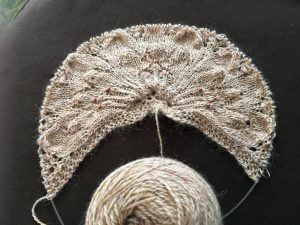 Apparently, I love a good knitting challenge. Sometimes I would get through a chart with few problems but other times I had to backtrack and begin again. I slowly worked my way through about half of the charts and then had to set this project aside while I completed holiday gifts for family and friends. After hibernating for at least three months, I pulled out this project and, amazingly, was able to pick up where I left off. I thank kc for that. The app holds my place exactly.
Apparently, I love a good knitting challenge. Sometimes I would get through a chart with few problems but other times I had to backtrack and begin again. I slowly worked my way through about half of the charts and then had to set this project aside while I completed holiday gifts for family and friends. After hibernating for at least three months, I pulled out this project and, amazingly, was able to pick up where I left off. I thank kc for that. The app holds my place exactly.
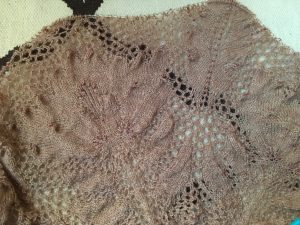 The process of knit, unknit, knit again continued but it was more like a fun puzzle than any sort of problem. I enjoyed figuring out how to make the stitches look like they were supposed to and watching the shawl grow. It was timely that I was taking a brief break from my usual routines because this was not exactly social knitting; focused concentration was required. The brief break also yielded plenty of time at home so I could sit and knit. I was fortunate to have the time and space.
The process of knit, unknit, knit again continued but it was more like a fun puzzle than any sort of problem. I enjoyed figuring out how to make the stitches look like they were supposed to and watching the shawl grow. It was timely that I was taking a brief break from my usual routines because this was not exactly social knitting; focused concentration was required. The brief break also yielded plenty of time at home so I could sit and knit. I was fortunate to have the time and space.
In the end, the knitting went pretty quickly. Well, relatively speaking. Rows with more than 400 stitches of beads and lace do not go quickly but once I was more monogamous with this project, I was able to complete it sooner than anticipated. Then came the next challenge. The very last row of the entire shawl looked, in my humble opinion, like crap! A picot bind off with too many yarn overs in the proceeding row, combined with yarn with too much halo that would not unknit after binding off ended up looking like boucle yarn in the very last row and that is NOT what I was aiming for. So, I had to let go of my expectations. I had to accept. I had to do a lot of breathing. OK – to be honest there was a bit of cursing, too. In the end I have a beautiful shawl of complicated lace and beads with a not so nice-looking bind off. And, in the end, I enjoyed the challenge of both complicated lace knitting and being mindful about it all. So, I accept my nice shawl with the funky edge.
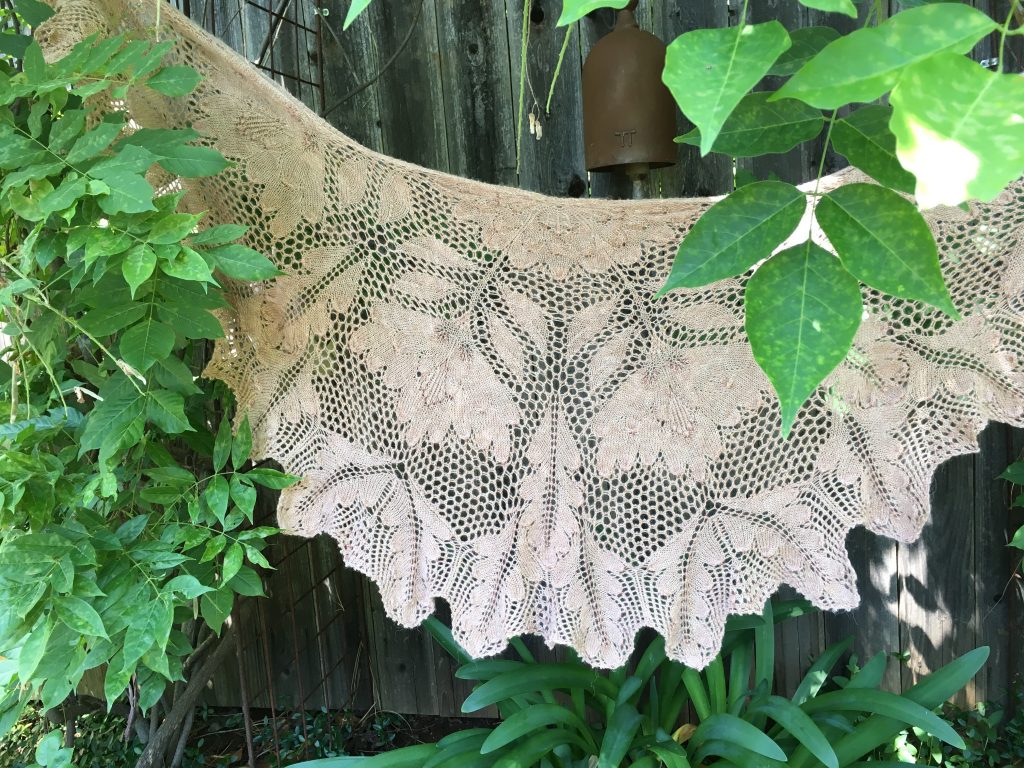
In between lace sessions and then after completing the shawl, I finished my complicated cable cape. 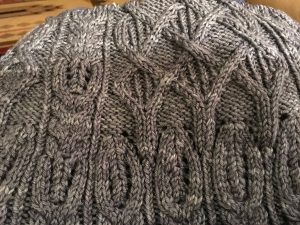
It began as a challenging knit, providing ample Mindfulness practice opportunities, and ended up a bit boring (no fault of the designer), providing a different kind of practice opportunity: patience and presence.
And I am always better off practicing patience and presence.
Happy knitting and breathing! 